Themed collection 5 years of nanomaterial analysis by means of ICP-MS

Field-flow fractionation and inductively coupled plasma mass spectrometer coupling: History, development and applications
This review presents the current knowledge about FFF-ICP-MS hyphenation, its history, its state-of-the-art technology for qualitative and quantitative analysis, its applications and further challenges with this technique.
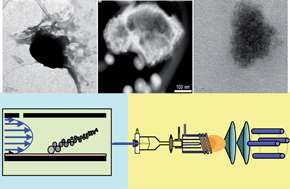
J. Anal. At. Spectrom., 2010,25, 613-623
https://doi.org/10.1039/B927500B
Field-flow fractionation with inductively coupled plasma mass spectrometry: past, present, and future
Historical background, recent applications, and the future trends of field-flow fractionation-inductively coupled plasma mass spectrometry.
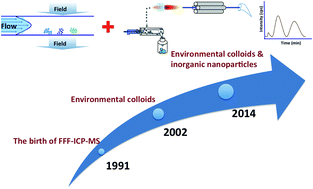
J. Anal. At. Spectrom., 2014,29, 1739-1752
https://doi.org/10.1039/C4JA00207E
Application of plasma spectrometry for the analysis of engineered nanoparticles in suspensions and products
Scanning electron micrograph of gold nanoparticles prepared with a low concentration of silver nitrate.
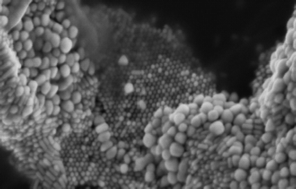
J. Anal. At. Spectrom., 2011,26, 1701-1721
https://doi.org/10.1039/C1JA10071H
Capabilities of inductively coupled plasma mass spectrometry for the detection of nanoparticles carried by monodisperse microdroplets
An inductively coupled plasma mass spectrometry (ICP-MS)-based system was developed to deliver and analyze gold and silver nanoparticles carried by monodisperse microdroplets.
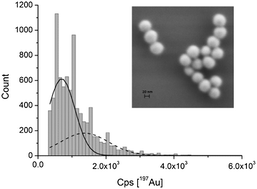
J. Anal. At. Spectrom., 2011,26, 1166-1174
https://doi.org/10.1039/C0JA00249F
First steps towards a generic sample preparation scheme for inorganic engineered nanoparticles in a complex matrix for detection, characterization, and quantification by asymmetric flow-field flow fractionation coupled to multi-angle light scattering and ICP-MS
Engineering nanoparticles in complex matrices.
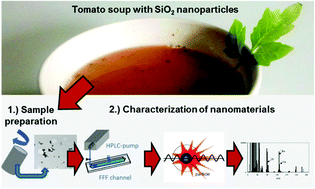
J. Anal. At. Spectrom., 2015,30, 1286-1296
https://doi.org/10.1039/C4JA00471J
Single particle ICP-MS combined with a data evaluation tool as a routine technique for the analysis of nanoparticles in complex matrices
spICP-MS measurement with a powerful data evaluation tool is presented as a fast, cost efficient and easy to use screening tool for metal and metal oxide NPs in complex matrices.
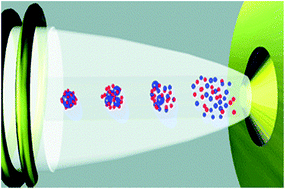
J. Anal. At. Spectrom., 2015,30, 1274-1285
https://doi.org/10.1039/C4JA00357H
Quantitative characterization of silica nanoparticles by asymmetric flow field flow fractionation coupled with online multiangle light scattering and ICP-MS/MS detection
A reliable and sensitive analytical method for the simultaneous determination of size and mass concentration of silica nanoparticles sized 20–200 nm.
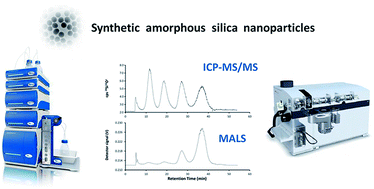
J. Anal. At. Spectrom., 2015,30, 1266-1273
https://doi.org/10.1039/C4JA00478G
Calibration of single-particle inductively coupled plasma-mass spectrometry (SP-ICP-MS)
Incomplete vaporization and non-linear detector response in pulse counting mode cause non-linearity in single-particle ICP-MS.
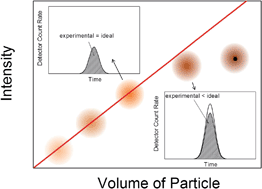
J. Anal. At. Spectrom., 2015,30, 1245-1254
https://doi.org/10.1039/C4JA00408F
Investigation of silver nanoparticles and plasma protein association using flow field-flow fractionation coupled with inductively coupled plasma mass spectrometry (FlFFF-ICP-MS)
Use of FlFFF-ICP-MS for observation of protein–AgNPs binding and evaluation of the binding stoichiometry.
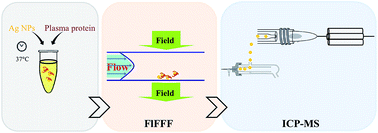
J. Anal. At. Spectrom., 2015,30, 245-253
https://doi.org/10.1039/C4JA00225C
Quantitative resolution of nanoparticle sizes using single particle inductively coupled plasma mass spectrometry with the K-means clustering algorithm
The K-means algorithm was applied to the signal processing for spICP-MS to improve the accuracy of size distribution analysis and quantitatively resolve nanoparticle sizes.
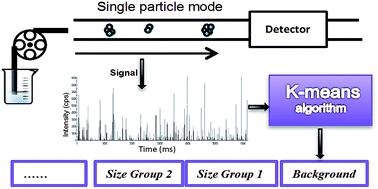
J. Anal. At. Spectrom., 2014,29, 1630-1639
https://doi.org/10.1039/C4JA00109E
Rapid size characterization of silver nanoparticles by single particle ICP-MS and isotope dilution
The increasing application of silver nanoparticles (AgNP) in consumer products and their potential release into the environment call for intensive investigation of their toxicity, stability, and fate.
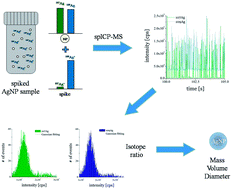
J. Anal. At. Spectrom., 2014,29, 1265-1272
https://doi.org/10.1039/C4JA00115J
Effect of dwell time on single particle inductively coupled plasma mass spectrometry data acquisition quality
Effect of dwell time on mean particle size calculation for 250 000 particles per mL of 60 nm Au NPs nebulized at 300 μL min−1.

J. Anal. At. Spectrom., 2014,29, 1252-1257
https://doi.org/10.1039/C4JA00097H
Improving the accuracy of single particle ICPMS for measurement of size distributions and number concentrations of nanoparticles by determining analyte partitioning during nebulisation
The analyte is redistributed between the waste and plasma flows. These analyte partitioning effects need to be corrected to obtain the most accurate size calibration of spICPMS.
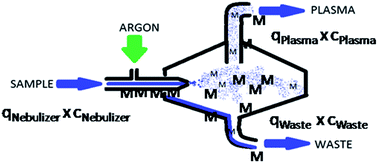
J. Anal. At. Spectrom., 2014,29, 743-752
https://doi.org/10.1039/C3JA50367D
A signal deconvolution method to discriminate smaller nanoparticles in single particle ICP-MS
Deconvolution removes overlapping dissolved signals from spICP-MS signals allowing analysis of smaller particles than hitherto possible.

J. Anal. At. Spectrom., 2014,29, 134-144
https://doi.org/10.1039/C3JA50160D
Accelerated evaporation of microdroplets at ambient conditions for the on-line analysis of nanoparticles by inductively-coupled plasma mass spectrometry
The helium-assisted evaporation and desolvation of pure or saline microdroplets at ambient lab conditions for the on-line analysis of individual nanoparticles by ICP-MS is reported.

J. Anal. At. Spectrom., 2013,28, 1707-1717
https://doi.org/10.1039/C3JA50052G
Critical considerations for the determination of nanoparticle number concentrations, size and number size distributions by single particle ICP-MS
The metrological criteria for the implementation of single particle inductively coupled plasma mass spectrometry in relation to nanoparticle size characterization and quantification are reported and applied to the identification of nanomaterials.
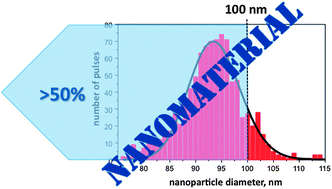
J. Anal. At. Spectrom., 2013,28, 1220-1232
https://doi.org/10.1039/C3JA50100K
A prototype of a new inductively coupled plasma time-of-flight mass spectrometer providing temporally resolved, multi-element detection of short signals generated by single particles and droplets
Multi-element time-resolved detection of transient signals of single microdroplets and particles by a prototype ICPTOFMS.
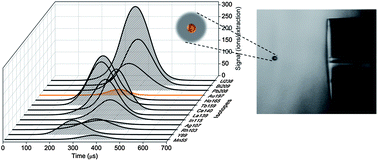
J. Anal. At. Spectrom., 2013,28, 226-233
https://doi.org/10.1039/C2JA30227F
Fraction-related quantification of silver nanoparticles via on-line species-unspecific post-channel isotope dilution in combination with asymmetric flow-field-flow fractionation (AF4)/sector field ICP-mass spectrometry (ICP-SF-MS )
An approach for quantifying silver nanoparticle fractions after asymmetric flow-field-flow fractionation separation relying on on-line isotope dilution ICP-MS is presented.

J. Anal. At. Spectrom., 2014,29, 287-296
https://doi.org/10.1039/C3JA50179E
Investigating agglomeration and dissolution of silica nanoparticles in aqueous suspensions by dynamic reaction cell inductively coupled plasma-mass spectrometry in time resolved mode
Dynamic reaction cell inductively coupled plasma-mass spectrometry in time resolved mode was used to investigate agglomeration and dissolution of silica nanoparticles.
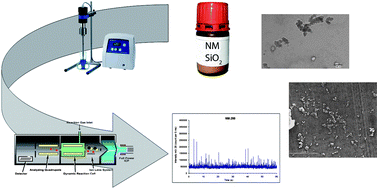
J. Anal. At. Spectrom., 2012,27, 1540-1548
https://doi.org/10.1039/C2JA30133D
Analysis of gold nanoparticle mixtures: a comparison of hydrodynamic chromatography (HDC) and asymmetrical flow field-flow fractionation (AF4) coupled to ICP-MS
This study is the first direct comparison of HDC and AF4 for gold nanoparticle characterization.
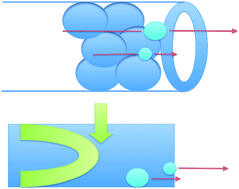
J. Anal. At. Spectrom., 2012,27, 1532-1539
https://doi.org/10.1039/C2JA30069A
Considerations for measurement of individual nanoparticles or microparticles by ICP-MS: determination of the number of particles and the analyte mass in each particle
Unique considerations to measure nanoparticles and microparticles using ICP-MS with sequential detection are discussed.
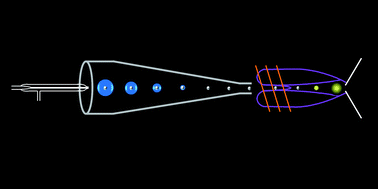
J. Anal. At. Spectrom., 2012,27, 1143-1155
https://doi.org/10.1039/C2JA30073G
Critical aspects of sample handling for direct nanoparticle analysis and analytical challenges using asymmetric field flow fractionation in a multi-detector approach
The analysis of engineered nanomaterials (ENMs), especially engineered nanoparticles (ENPs), is a fast growing analytical research field.
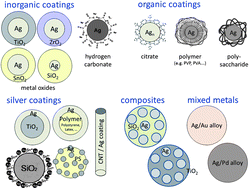
J. Anal. At. Spectrom., 2012,27, 1120-1130
https://doi.org/10.1039/C2JA30024A
Silver nanoparticle characterization using single particle ICP-MS (SP-ICP-MS) and asymmetrical flow field flow fractionation ICP-MS (AF4-ICP-MS)
Methods to detect, quantify, and characterize engineered nanoparticles (ENPs) in environmental matrices are highlighted as one of the areas of highest priority research needs with respect to understanding the potential environmental risks associated with nanomaterials.
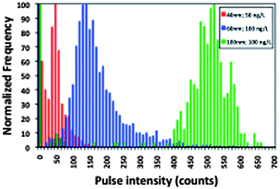
J. Anal. At. Spectrom., 2012,27, 1131-1142
https://doi.org/10.1039/C2JA30021D
Improved sample preparation and quality control for the characterisation of titanium dioxide nanoparticles in sunscreens using flow field flow fractionation on-line with inductively coupled plasma mass spectrometry
First systematic comparison and optimisation of extraction methods for the characterisation of titanium dioxide nanoparticles in sunscreens using FFF-ICP-MS.
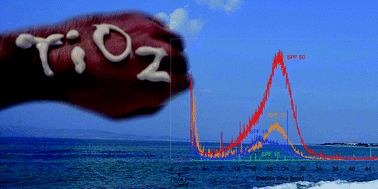
J. Anal. At. Spectrom., 2012,27, 1084-1092
https://doi.org/10.1039/C2JA10387G
Overcoming challenges in analysis of polydisperse metal-containing nanoparticles by single particle inductively coupled plasma mass spectrometry
Effects of coincidence in analysis of highly polydisperse nanoparticles by single particle ICP-MS.
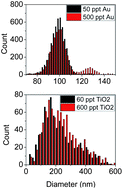
J. Anal. At. Spectrom., 2012,27, 1093-1100
https://doi.org/10.1039/C2JA30061C
Single particle inductively coupled plasma mass spectrometry : evaluation of three different pneumatic and piezo-based sample introduction systems for the characterization of silver nanoparticles
Analytical performance of three sample introduction systems (PC3, Apex Q, Microdrop) is compared for the characterization of 20–100 nm Ag nanoparticles.
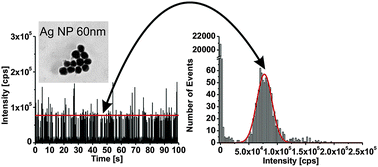
J. Anal. At. Spectrom., 2012,27, 1074-1083
https://doi.org/10.1039/C2JA00003B
Selective identification, characterization and determination of dissolved silver(I) and silver nanoparticles based on single particle detection by inductively coupled plasma mass spectrometry
A methodological approach is reported based on single particle detection using ICP-MS for identification, characterization and quantitation of dissolved silver and silver nanoparticles in aqueous suspensions.
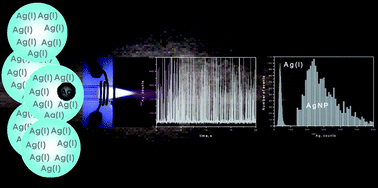
J. Anal. At. Spectrom., 2011,26, 1362-1371
https://doi.org/10.1039/C0JA00098A
Direct detection and isotope analysis of individual particles in suspension by single particle mode MC-ICP-MS for nuclear safety
Direct detection and precise isotope analysis of individual particles in suspension by single particle mode MC-ICP-MS.
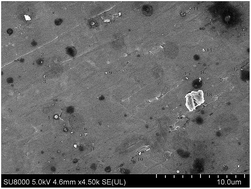
J. Anal. At. Spectrom., 2015,30, 1184-1190
https://doi.org/10.1039/C4JA00339J
About this collection
Guest Edited by Björn Meermann and Francisco Laborda this online collection showcases advances in ICP-MS for characterising and analysing nanomaterials. Articles from 2010 to 2015 are included in the collection and new articles will continue to be added throughout 2015.
Also see our related collection, 'Analysis of nanomaterials by FFF- and single particle ICP-MS'